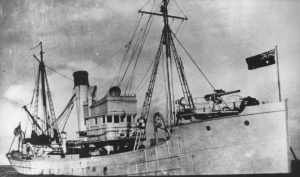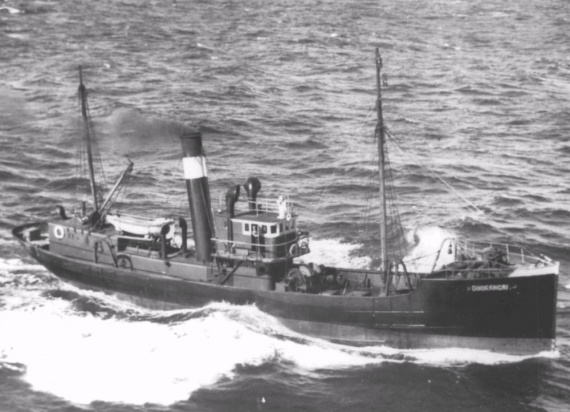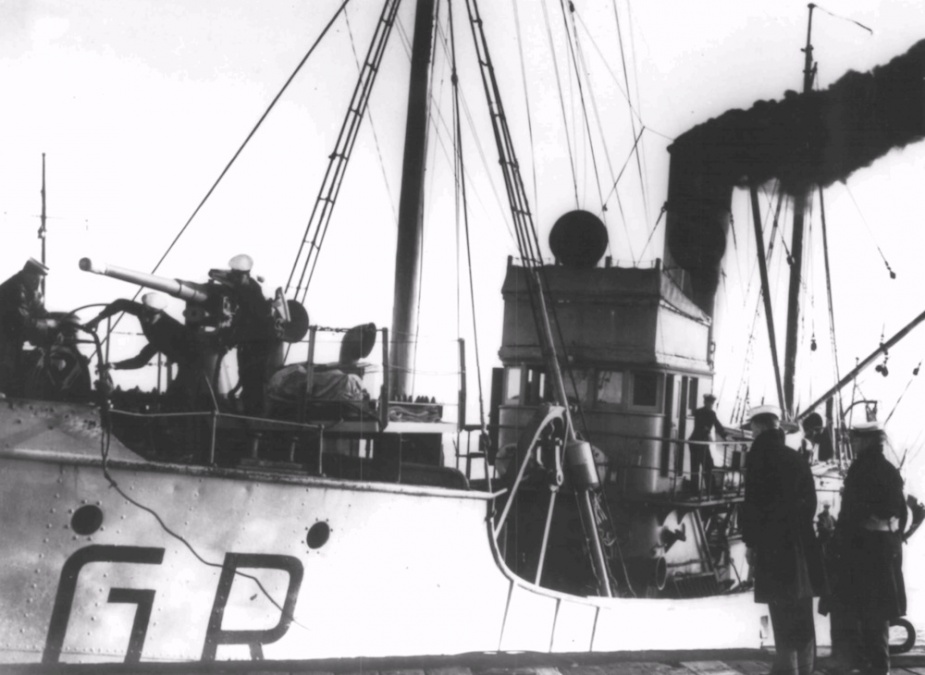HMAS Goorangai
| Type |
Steam Trawler |
|---|---|
| Pennant |
GR |
| Builder |
State Dockyard, Newcastle, NSW |
| Commissioned |
9 October 1939 |
| Decommissioned |
20 November 1940 |
| Fate |
Sunk after collision with MV Duntroon |
| Dimensions & Displacement | |
| Displacement | 223 tons |
| Length | 117 feet |
| Beam | 22 feet 1 inch |
| Draught | 13 feet 8 inches |
| Performance | |
| Speed | 9.5 knots |
| Complement | |
| Crew | 24 |
| Armament | |
| Guns | 1 x 12-pounder QF gun |
| Other Armament | Depth charges |
The steam trawler MV Goorangai was built for the New South Wales Government at the State Dockyard in Newcastle in 1919 and was sold to Cam & Sons Pty Ltd of Sydney in 1926. She was requisitioned for naval service on 8 September 1939, one of eight vessels requisitioned from Cam & Sons, and commissioned as HMAS Goorangai at Melbourne on 9 October 1939 for service as an auxiliary minesweeper. She joined Minesweeping Group 54 in Melbourne and operated primarily in Bass Strait.
In the evening of 20 November 1940, while en route from Queenscliff to Portsea in Port Phillip Bay where she intended to anchor for the evening, she collided with the 10,364 ton, outward bound passenger liner, MV Duntroon, which struck her amidships on the port side. Duntroon’s captain had believed that she was on a parallel course to Goorangai and overtaking her. By the time he realised Goorangai’s true course, with Duntroon travelling at more than 17 knots, it was too late to avoid the collision. Goorangai was cut in two and sank in less than a minute with the loss of her entire crew of 24. Just six bodies were recovered in subsequent salvage operations. She was the first RAN ship sunk in the Second World War.
The wreck of Goorangai lay inside the shipping transit zone in less than 15 metres of water and was considered a hazard to navigation. She was demolished by explosive charges early in 1941.
The news of the collision quickly reached media outlets ashore which believed that normal wartime censorship provisions did not apply, as Goorangai’s loss was not due to enemy action and did not involve aspects of security, and claimed the right of immediate publication. The Naval Board, however, secured a censorship ban until the next-of-kin of those lost had been informed, an action later upheld by the Government. On 10 December, the War Cabinet confirmed supplementary censorship instructions which provided for the loss of service personnel in accidents in Australia or Australian waters.
On 16 November 1995, the wreck of Goorangai was declared a historic shipwreck as specified in the Historic Shipwrecks Act (1981).
The men who lost their lives in HMAS Goorangai on 20 November 1940 were:
- Commissioned Officer from Warrant Rank D McGregor, RANR(S)
- Warrant Officer KJ Matheson, RANR(S)
- Lieutenant Commander GW Boyle, RANR, Minesweeping Advisor
- Steward B Buchanan, RANR
- Ordinary Seaman A Carter, RANR
- Signalman CC Cox, RANR
- Signalman JH Dungey, RANR
- Able Seaman NL Farquharson, RANR
- Engine Room Artificer H Gilroy, RANR
- Chief Engine Room Artificer CW Green, RANR
- Ordinary Seaman FR Hack, RANR
- Stoker H.H. Johnson, RANR
- Ordinary Seaman WV Johnston, RANR
- Leading Seaman A Kemp, RANR
- Able Seaman ATR Ladlow, RANR
- Ordinary Telegraphist A MacDonell, RANR
- Stoker E McLaughlan, RANR
- Cook, MW Madden, RANR
- Stoker LWK Mainsbridge, RANR
- Leading Stoker J Moxey, RANR
- Engine Room Artificer RP Redman, RANR
- Able Seaman J Sanders, RANR
- Petty Officer FH Wadds, RANR
- Able Seaman R Wadrop, RANR











